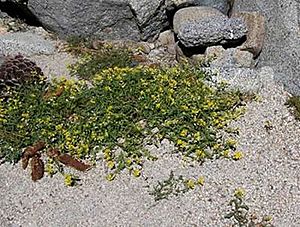Lake Tahoe yellowcress facts for kids
Quick facts for kids Lake Tahoe yellowcress |
|
|---|---|
 |
|
| Conservation status | |
| Scientific classification | |
| Genus: |
Rorippa
|
| Species: |
subumbellata
|
The Lake Tahoe yellowcress (Rorippa subumbellata) is a very rare flowering plant. It belongs to the Brassicaceae family, which includes plants like mustard. This special plant grows only on the shores of Lake Tahoe. Lake Tahoe is a large freshwater lake located in the Sierra Nevada mountains. It sits right on the border between California and Nevada.
Scientists believe there are only about fourteen groups, or "populations," of this plant left. These plants live in a small area right by the lake's edge. This area is about seven feet wide. It is between where the water usually reaches its highest and lowest points. Because it lives so close to the water, the plant is easily affected by people's activities on the lake.
Contents
About Lake Tahoe Yellowcress
What Does It Look Like?
The Lake Tahoe yellowcress is a perennial plant. This means it lives for more than two years. It is also an herb, which means it has soft stems, not woody ones like a tree. Its stems can grow up to 20 centimeters (about 8 inches) long. These stems spread out and have many branches. They are also covered in tiny hairs.
The leaves of the plant are small, usually 1 to 3 centimeters long. They are shaped like an oval or a spear. Their edges can be wavy or divided into small sections.
Its Flowers and Seeds
The plant produces small, yellow flowers. They grow in a tight cluster called an inflorescence. This cluster is shaped like a raceme, which means the flowers grow along a central stem. Each flower looks a bit like a tiny mustard flower. Its petals are about 3 millimeters long.
After the flowers bloom, they produce a fruit. This fruit is called a silique. It is a few millimeters wide and does not have hairs. Inside the silique are very tiny seeds.
Where Does It Live?
The Lake Tahoe yellowcress is unique because it only grows on the direct shoreline of Lake Tahoe. It needs a special semi-aquatic zone. This zone is where the land meets the water. It is often wet but can also dry out. This specific habitat is crucial for the plant's survival.
The size of the plant groups changes with the lake's water level. When the water level drops, more sandy beach is exposed. This gives the yellowcress more space to grow. So, the plant populations tend to get bigger when the lake's water is lower.
Why Is It Endangered?
The Lake Tahoe yellowcress faces many threats. Because it lives right on the shoreline, it is easily harmed by human activities. For example, boat wakes (waves made by boats) can hit the plants. People walking on the beach can accidentally step on them. Also, building docks and other structures on the shore can destroy their habitat.
Sometimes, high water levels can help the plant. They can kill off other plant species that compete for space on the beaches. However, overall, human activities and changes in water levels make it hard for the yellowcress to thrive.
Helping the Plant Survive
Protecting the Lake Tahoe yellowcress is very important. Scientists and conservation groups are working to help this rare plant. One challenge has been getting the seeds to sprout. For a long time, it was hard to grow new plants from seeds.
However, recent studies have found ways to improve seed germination. This means more seeds are now able to grow into new plants. These efforts are vital for the future of the Lake Tahoe yellowcress. They help ensure this unique plant continues to be a part of Lake Tahoe's natural beauty.


